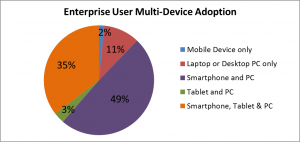At EMA, we constantly receive inquiries regarding what OpenStack means to the VMware portfolio. Is it a competing technology? Are OpenStack and vCloud complementary? Why did VMware join OpenStack? What are the typical use cases for OpenStack as opposed to vCloud? To address these questions, let’s take a step back and take a look at what OpenStack is and, as importantly, what it is not. This post is building on my previous article on the business value of OpenStack.
What is OpenStack?
OpenStack is a toolkit that includes a set of modules for compute (Nova), network (Quantum) and storage (Cinder and Swift) automation, as well as additional modules for image management (Glance) and identity management (Keystone). The purpose of each of these modules is to provision, pool and, to a degree, manage infrastructure resources. KVM is the OpenStack hypervisor of choice, but OpenStack also supports Xen, ESXi, HyperV and PowerVM to various degrees (see the official OpenStack hypervisor support matrix). OpenStack distributions are currently available through a number of companies, such as Cloudscaling, Piston Cloud Computing, SUSE, Ubuntu, Cisco and RedHat.
The OpenStack architecture was designed to be highly scalable -keep in mind that this scalability has not been proven in production environments- and initially aimed at modern distributed application workloads, such as the ones that are currently placed to Amazon EC2 or Microsoft Windows Azure. Out of the box OpenStack is lacking proven core capabilities –security management, network control, authentication, high availability, performance management and storage– that are required for running more traditional applications. Within this context, it is essential to understand that it may not be in the best interest of the OpenStack members to conclusively resolve these issues, as they typically use OpenStack as a part of a much larger proprietary cloud solution (see my Impact Brief on IBM SmartCloud Orchestrator). Without there being room for vendors to add their own secret sauce, their tremendous investments in the base OpenStack platform would be difficult to justify to shareholders.
What OpenStack is not
OpenStack is not a turnkey cloud platform and should also not be regarded as a viable environment for traditional enterprise applications. It is essential to understand that OpenStack is not a stand-alone product, but a starting point or foundation for an enterprise cloud deployment. While OpenStack is in the process of developing increased orchestration, image lifecycle and identity management capabilities, it is not a PaaS offering.
In a Nutshell
OpenStack is a massively scalable open source IaaS platform that targets modern applications that are written for the cloud. The fact that, despite all the marketing noise, only a small percentage of enterprise applications are designed for this type of cloud, underlines that OpenStack is a platform that will need to coexist with traditional virtualization and cloud platforms, such as vCloud or CloudStack. Therefore, what is often touted as the “OpenStack revolution” is much more of an evolution that often starts with small dev/test deployments. To put this into perspective, while the largest CloudStack production deployments manage over 40,000 physical hosts, I have personally not talked to OpenStack customers managing more than a few dozen hosts in a true production environment.
OpenStack: Opportunity or Threat for VMware
The answer to the question of whether OpenStack is a threat or an opportunity for VMware is non-trivial. Fact is that KVM is the OpenStack hypervisor of choice and that most OpenStack members would happily see their customers migrate to a free hypervisor, as this would free up budget dollars for other projects. At the same time, OpenStack members are pushing for OpenStack to better support VMware’s ESXi hypervisor, as a large junk of corporate workloads is still required to be hosted on the VMware virtualization platform. Whether or not certain workloads actually require ESXi or if they could just as well run on KVM is an interesting question for another blog post. However, most organizations have clear cut policies regarding which hypervisors can be used for what type of workload and ESXi, closely followed by Hyper-V, is still the leader for mission critical applications. While OpenStack has the ambition to eventually establish feature parity between all the supported virtualization platforms, additional time will be required to a) achieve this goal and b) convince customers that KVM can be trusted in a production scenario.
In addition, VMware’s strategic acquisitions in the network virtualization (Nicira) and storage hypervisor (Virsto) realms are aimed at boosting the company’s differentiators in the virtualization arena and may enable VMware to maintain its market leadership for a while. While OpenStack Quantum includes software defined networking and network virtualization technology (originally contributed by Nicira), these capabilities are unproven in production environments. The same is the case for Cinder and Swift, OpenStack’s block and object storage modules.
At the same time, VMware is moving its focus up the stack, heavily investing into the vCenter Operations Management Suite, vCloud Automation Center (formerly DynamicOps) and the vFabric Application Management Platform. These three product lines must be seen as VMware’s key strategic assets going forward. VMware’s collaboration with PuppetLabs –VMware made a $30 million investment in Puppet earlier this year– is an indicator for the fact that the company understands the importance of further extending its data center management and automation capabilities.
Conclusion: OpenStack Is a Double Edged Sword for VMware
Without any doubt, OpenStack constitutes a disruptive force within the virtualization and cloud market place. It is now up to VMware to decide whether to embrace this new technology or whether to aggressively compete with it. In my opinion, there is only one right answer. As much as we can talk about existing differentiators within VMware’s virtualization platform, it is fact that virtualization –server, network, and compute- is going to be a commodity. Therefore, VMware needs to focus on its operations and application management platforms. However, this also means that the company will compete head on with the Big 4 on their own turf. This will certainly not be an easy battle. However, EMA research has shown that 50% of companies will look at vCloud first, before considering Big 4 or open source technologies. If VMware can capture this tremendous advantage by offering its customers a solution that is open and interoperable with OpenStack and other cloud platforms, I’m optimistic that VMware will continue to play a leading role in virtualization management and cloud in the future.




